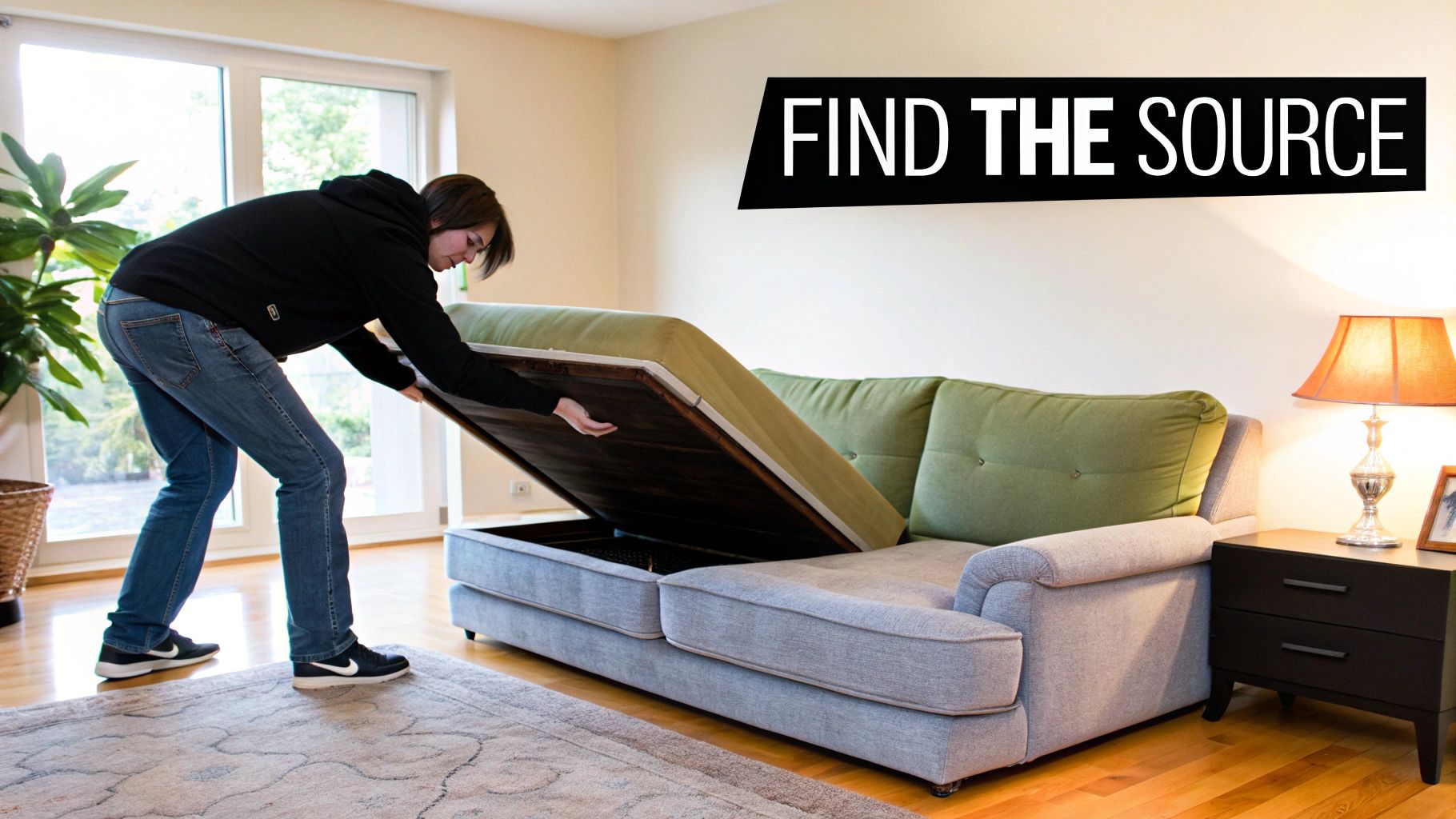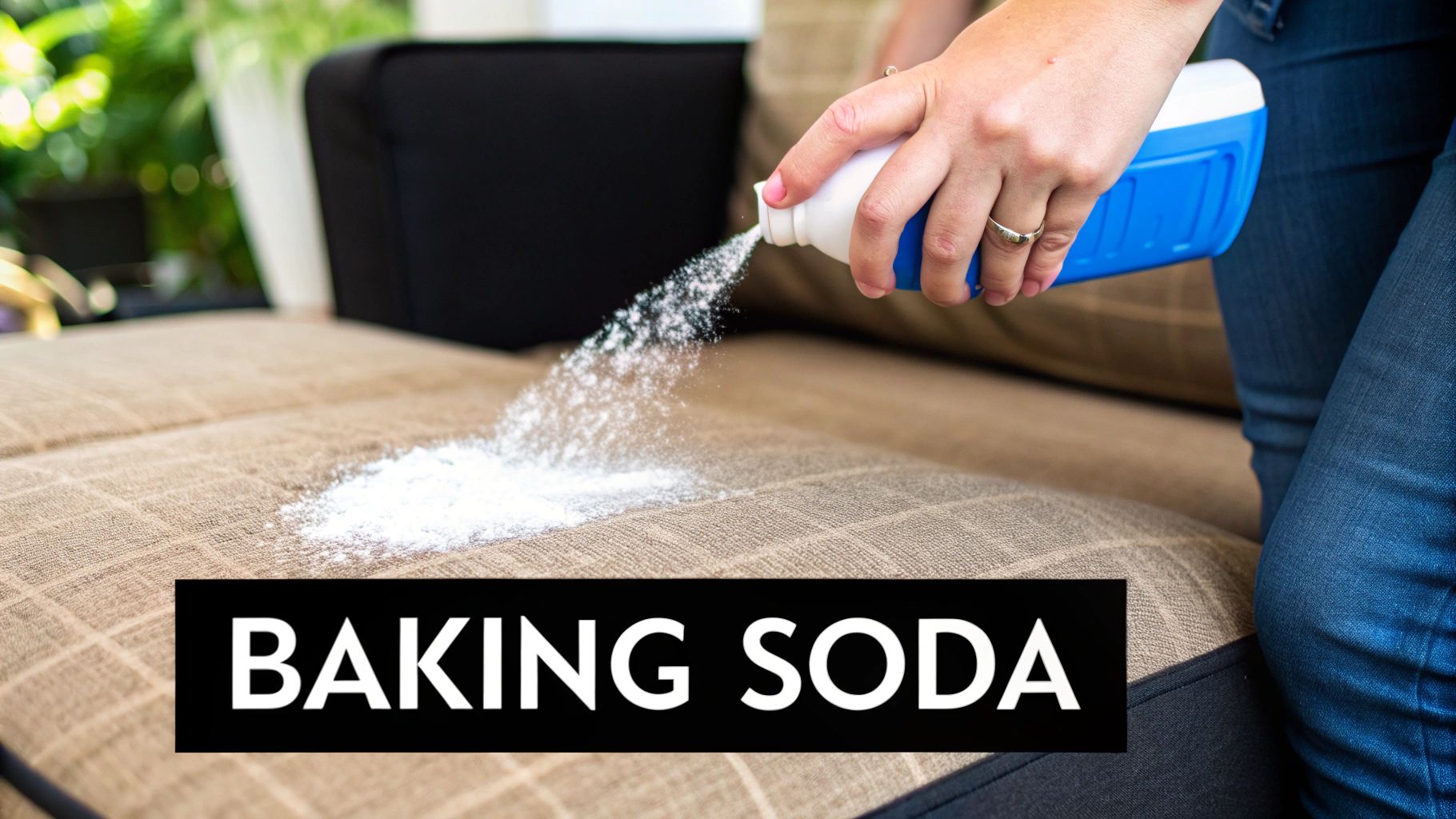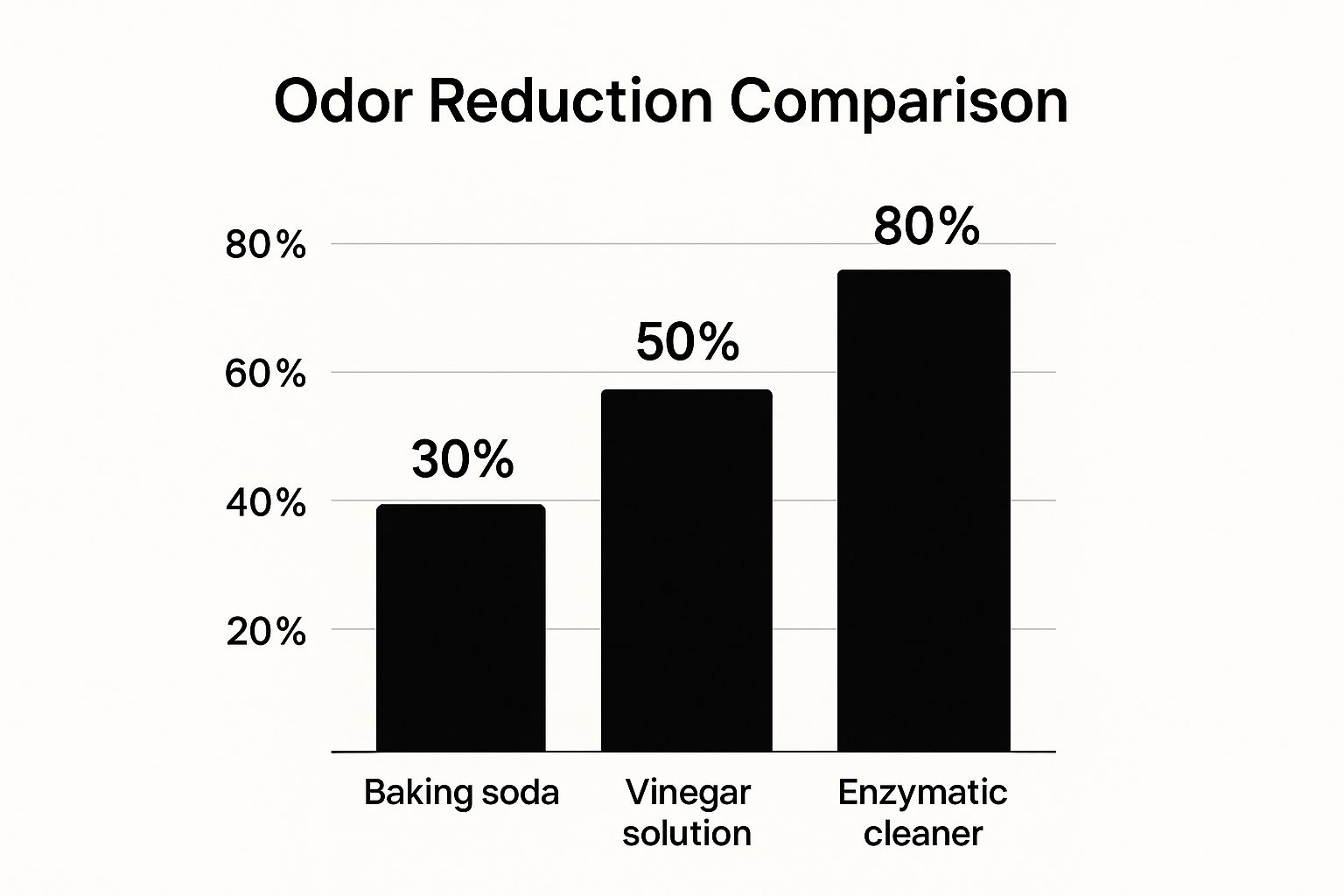If you need a quick fix for that doggy smell on your couch, your vacuum and a box of baking soda are your best friends. Start with a really thorough vacuuming of the whole couch—get into every nook and cranny. Then, sprinkle a generous layer of baking soda all over the fabric. Let it sit for a few hours (or even overnight if you can) to soak up the odors, then vacuum it all up.
Understanding That Lingering Dog Smell

So, what's behind that persistent "dog smell" that seems to cling to your furniture? It’s not just a few stray hairs. It's actually a potent cocktail of your dog's natural body oils, dander (those tiny flakes of dead skin), and the bacteria that love to feed on all of it.
These microscopic culprits work their way deep into the upholstery fibers. This creates an odor that can feel impossible to get rid of, often reappearing no matter how much you try to air out the room.
It’s such a common frustration that it has sparked a massive industry. The pet odor control market was valued at over USD 14.16 billion and is still climbing. This growth is largely driven by the rising number of pet owners in apartments and urban homes where getting rid of furniture smells is a huge priority. You can learn more about the growth of the pet odor control market and see just how big this issue is.
Before diving into deep-cleaning methods for specific fabrics, let's focus on getting you some immediate relief. That simple vacuum and baking soda combo is a surprisingly powerful first line of defense.
Pro Tip: Don't just skim the surface when you vacuum. Grab the upholstery attachment and crevice tool. Pet dander, hair, and oils love to collect in the seams and under the cushions, creating concentrated odor hot spots. A meticulous initial vacuum makes every other cleaning method way more effective.
Your First Line Of Defense
Think of this as your emergency fix. It might not tackle deep-set stains from accidents, but it will dramatically knock down that general dog smell you notice when you walk in the room. To help you pick the right tool from your pantry, here’s a quick rundown of common DIY deodorizers you can use right now.
Quick DIY Couch Deodorizers
Here's a quick-reference guide to common household items that can work wonders on neutralizing dog odors clinging to your couch. These are great for a fast refresh before you decide on a deeper clean.
| Deodorizer | Best For | Application Method | Caution |
|---|---|---|---|
| Baking Soda | General odor absorption on dry fabric surfaces. | Sprinkle a thick layer, let it sit for several hours or overnight, then vacuum thoroughly. | Make sure you vacuum it all up. Leftover residue can be mildly irritating to some pets' skin. |
| White Vinegar Solution | Neutralizing strong, alkaline-based odors like urine. | Mix equal parts white vinegar and water in a spray bottle. Lightly mist the fabric and let it air dry completely. | Always test on a hidden spot first to check for colorfastness. Not suitable for all fabric types, especially delicate ones. |
| Activated Charcoal | Passive, long-term odor absorption in a targeted area. | Place bags of activated charcoal under or near the couch cushions. | This is a slow and steady method. It won't give you a rapid fix for a strong, sudden smell. |
Using one of these simple solutions can provide immediate relief and make your living space feel fresh again while you plan your next move.
Your Couch Cleaning Toolkit for Pet Odors

Before you can tackle that lingering dog smell on your couch, you’ve got to gear up. Having the right tools on hand makes all the difference, turning a frustrating chore into a successful mission. This isn't just about a shopping list; it’s about understanding your arsenal.
Your most important tool is a powerful vacuum. Look for one with a motorized pet brush attachment—it's essential for pulling up deeply embedded hair and dander from upholstery fibers. Standard attachments often just skim the surface, leaving the source of the smell behind.
Next, you'll need a good stack of microfiber cloths. Their unique texture is designed to trap and lift dirt, oils, and moisture without being abrasive, which is exactly what you need to protect your couch's fabric while you clean.
Essential Cleaning Agents
Your toolkit should include both simple DIY staples and a few specialized cleaners. These items work at a molecular level to actually neutralize odors, not just cover them up with a temporary fragrance.
- Baking Soda: This alkaline powder is a master at absorbing and neutralizing acidic odor molecules. It's a classic for a reason.
- Distilled White Vinegar: Its acidity is perfect for breaking down the bacteria that cause many common pet smells.
- Hydrogen Peroxide: An oxidizing agent that is fantastic for lifting organic stains on light-colored fabrics. Always spot-test first!
When you're gathering your supplies, it's crucial to pick products that are effective but also safe for your furry friends. We recommend looking into these pet-safe cleaning products to keep your home environment healthy for everyone.
For a truly deep clean that sanitizes and deodorizes, a steam cleaner can be a game-changer. Models with an injection feature can push a cleaning solution deep into the upholstery and then extract it along with all the grime. You can see how a powerful tool like the Dupray Hill Injection Steam Cleaner works in our detailed review.
These items form the foundation of an effective odor-busting toolkit, getting you ready for pretty much any mess your dog decides to leave behind.
Cleaning Methods for Every Couch Material

You wouldn't wash a silk shirt the same way you wash denim jeans, right? The same logic applies to your couch. Treating a tough microfiber sofa like a delicate leather one is a recipe for disaster. The real secret to getting dog smells out for good is matching your cleaning method to the material. Using the wrong stuff can leave you with watermarks, faded spots, or permanently damaged fabric.
Before you go all-in with any cleaner—whether it’s a DIY vinegar spray or a store-bought solution—always do a spot test. Find a hidden area, like under a cushion or on the back panel against the wall. Apply a small amount of your cleaner, let it dry, and check for any weird reactions. Trust me, this one simple step can save you a world of heartache.
It's no surprise the pet odor solution market is booming, and it's expected to hit nearly USD 14.97 billion by 2035. This is driven by new enzymatic and bio-based cleaners that are super effective and safe for your furry friends.
Tackling Fabric and Microfiber Couches
Most fabric couches—think polyester, microfiber, and cotton blends—are pretty forgiving. After giving the couch a really good vacuuming, a simple mix of equal parts distilled white vinegar and water in a spray bottle usually does the trick.
Just give the fabric a light misting (don't soak it!) and let it air dry. The vinegar smell disappears as it dries, taking those dog odors with it.
For stronger, more stubborn smells, a baking soda paste is your best friend:
- Mix baking soda with a little water until you get a thick paste.
- Spread the paste right on the smelly spot and let it dry completely.
- Once it's dry and crusty, vacuum it all up with a brush attachment.
Key Takeaway: With fabric, the goal is to clean without getting it too wet. Soaking the cushions can lead to mildew, which is a whole other smell you don't want to deal with. A fan or an open window will help speed up the drying time. And just like furniture, other surfaces in your home need their own special care. For example, our guide on how to clean hardwood floors covers techniques that won't damage the finish.
Caring for Leather and Natural Fibers
Leather is a completely different animal. It’s tough, but it needs the right care to keep it from drying out and cracking. Never use harsh chemicals or vinegar solutions on leather. Instead, just mix a few drops of mild dish soap into some warm water.
Get a soft microfiber cloth, dip it in the soapy water, and wring it out until it's just damp. Gently wipe down the entire couch. Right after, use a separate dry cloth to buff away any leftover moisture.
For delicate materials like wool or silk, moisture is the ultimate enemy. Dry cleaning methods are usually the safest route. Your best bet is a heavy sprinkle of baking soda left on overnight to absorb odors. For more tips on delicate materials, this guide on how to clean sheepskin has some great advice you can apply to similar fabrics. Always, always check the cleaning tag on your couch first.
Powerful DIY Recipes to Banish Dog Odors
You don’t always need to shell out for a pricey store-bought spray to get that dog smell out of your couch. Some of the most effective solutions are probably sitting in your pantry right now, offering a pet-safe and wallet-friendly alternative. The trick is knowing how to combine them for maximum odor-busting power.
The market for pet odor sprays is massive—North America held a 49% share in 2023, which isn't surprising when you consider that 62% of households own pets and are always looking for ways to keep things clean. While commercial products are handy, a well-made DIY recipe can be just as good, if not better.

As you can see, homemade solutions make a huge difference. However, for the absolute toughest jobs, enzymatic cleaners really shine by completely breaking down the organic stuff causing the smell.
Commercial vs DIY Cleaner Showdown
Deciding between a commercial enzymatic cleaner and a homemade solution often comes down to the specific job, your budget, and your preferences. I've broken down the key differences to help you choose the right tool for the task.
| Feature | Commercial Enzymatic Cleaners | DIY Vinegar/Baking Soda Solutions |
|---|---|---|
| Effectiveness | Highly effective; breaks down organic matter at a molecular level. | Good for surface odors and general freshness; may not eliminate deep-set smells. |
| Cost | Typically $15 - $25 per bottle, which can be pricey for large areas. | Very low cost; ingredients are common household staples, usually under $5. |
| Safety | Generally pet-safe, but always check labels for specific ingredients. | Completely natural and safe for pets and children. |
| Best For | Stubborn, old stains and odors from urine, vomit, or feces. | Everyday odors, general couch refreshing, and light pet smells. |
While DIY recipes are fantastic for regular maintenance and keeping things fresh, I always keep a good enzymatic cleaner on hand for those inevitable, more serious pet messes.
The Go-To Vinegar Neutralizing Spray
For a simple, all-purpose deodorizer, you can't beat a white vinegar solution. Its natural acidity is perfect for neutralizing the alkaline compounds that cause many common pet odors.
- Recipe: Just mix equal parts distilled white vinegar and water in a clean spray bottle.
- How to Use: Give your fabric couch a light misting, paying a little extra attention to the spots where your dog loves to hang out.
- What Happens Next: Let it air dry completely. The vinegar smell will fade as it evaporates, and it takes the dog smell right along with it.
This is my favorite method for a quick refresh, but always remember to test it on a small, hidden spot first to be safe. For more detailed advice on tackling really tough smells and stains, check out our guide on how to remove pet odors and stains.
Potent Paste for Set-In Smells
When you're up against a more concentrated or stubborn smell, a simple baking soda paste gives you a targeted, deep-cleaning punch right where you need it.
Important Safety Note: A crucial rule in cleaning is to never mix different household cleaners, especially anything containing ammonia and bleach. Mixing them can create dangerous toxic gases. Stick to simple, single-ingredient recipes like these to keep you and your pets safe.
To make the paste, just mix baking soda with a tiny bit of water until you get a thick, spreadable consistency. Apply it directly to the smelly spot on the couch, let it dry until it forms a crust, and then vacuum it all up. Easy.
Keeping Your Couch Fresh Day After Day
Getting rid of a tough dog smell feels like a huge win, but the real victory is making sure it doesn't come back. The secret? Shifting from frantic, reactive cleaning to simple, proactive habits. It's all about creating routines that stop odors in their tracks.
One of the easiest yet most effective things you can do is use washable couch covers or a few designated pet blankets. Think of them as a shield for your upholstery, catching the bulk of dander, hair, and oils before they have a chance to sink in. When they start to smell a bit funky, just toss them in the wash. Easy.
Build a Fresher Environment
Beyond just covering the couch, your daily and weekly habits are what truly make the difference. A few consistent routines can dramatically cut down on odor buildup, making your deep-cleaning efforts last so much longer.
- Regular Grooming: A well-groomed dog is a less stinky dog. Brushing your pup a few times a week gets rid of loose fur and dander that would otherwise find its way onto your furniture.
- Consistent Vacuuming: Make vacuuming the couch a non-negotiable part of your weekly cleaning. Be sure to use a pet-hair attachment to get deep into the crevices where all the smelly stuff loves to hide.
- Improve Air Circulation: Stale, stagnant air is an odor magnet. Just opening the windows for 15-20 minutes a day or running an air purifier can make a massive difference in keeping your whole living space smelling fresh.
If you find that pet dander and hair are your biggest culprits, you might even consider looking into certain dog breeds that don't moult to minimize future odor issues right from the source.
Common Questions About Couch Odor Removal
Even after you've tried everything, a few questions always seem to pop up. Getting dog smells out of a couch can feel like a never-ending battle, so let's clear the air on some of the things that stump pet owners the most.
How Long Should I Leave Baking Soda On My Couch?
If you're just doing a quick refresh, leaving baking soda on for a few hours will definitely help. But for those deep, set-in dog odors that have been lingering for a while, you'll want to go for the overnight treatment.
Let it sit for at least 8 hours. This gives the baking soda enough time to really work its magic and absorb all those stubborn, odor-causing molecules before you vacuum it all up.
Is Vinegar Safe for All Couch Fabrics?
Definitely not. While a diluted white vinegar solution is a fantastic cleaner for durable synthetics like microfiber or polyester, it can be a disaster for others. It’s often too acidic for delicate natural fibers and can damage certain types of treated leather.
The golden rule here is to always test your cleaning solution on a small, hidden spot first. It’s a simple step that can save you from a giant headache like discoloration or fabric damage.
Will a Steam Cleaner Get Rid of Dog Smells?
Yes, a steam cleaner can be a game-changer. The hot water vapor it uses gets deep into the fabric to clean and sanitize, killing the smelly bacteria at the source. Just make sure to check your couch’s tag for a “W” or “W/S” cleaning code, which means it’s safe for water-based cleaning.
But here’s a critical warning: never use high heat on a fresh urine stain. The heat can actually bond the proteins in the urine to the fabric fibers, setting the stain and smell permanently.
If you've tried everything and the odor just won't quit, it might be time to call in the pros. Custom Maids offers professional deep cleaning services that can bring your furniture back to life and freshen your whole home. Find out more about our specialized cleaning services at https://custom-maids.co.

